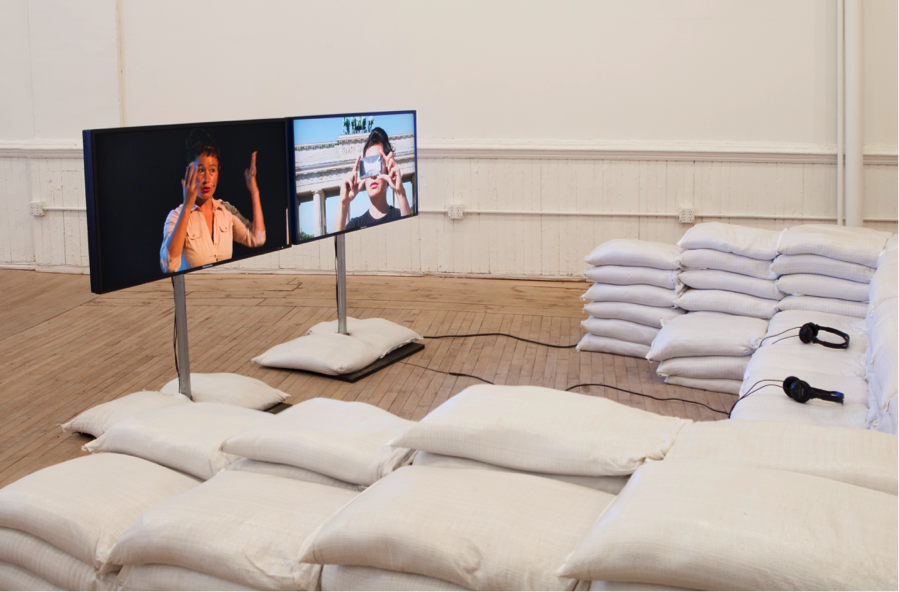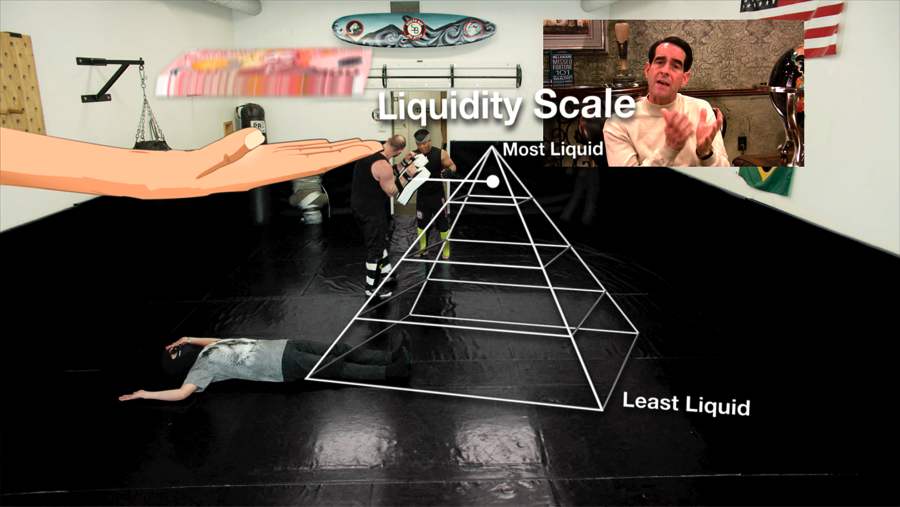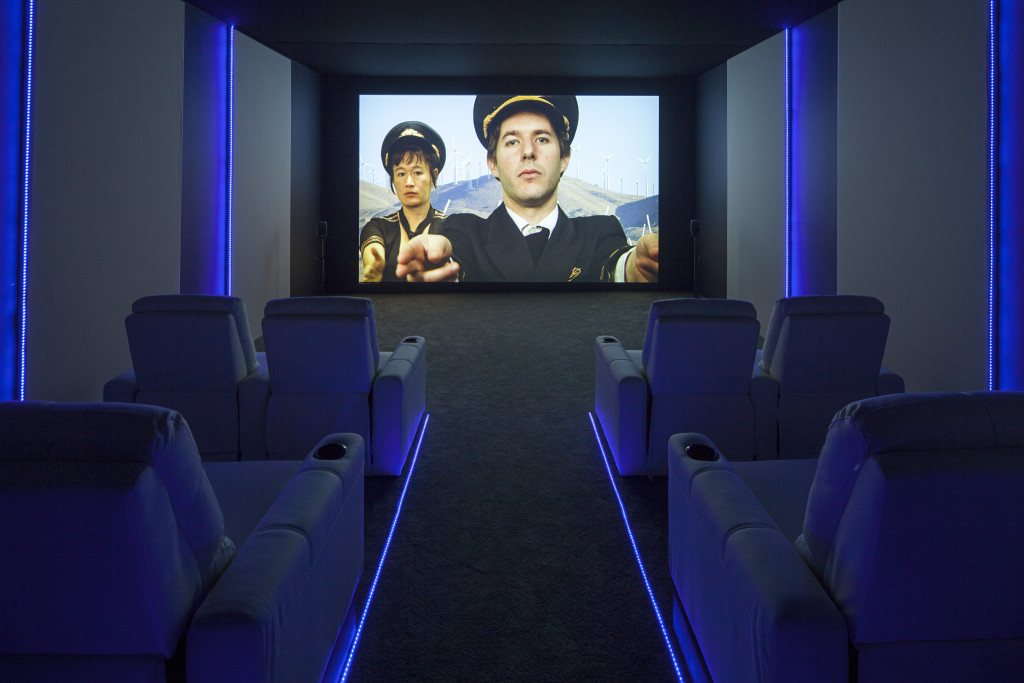Hito Steyerl: Artists Space
by Vanessa Gravenor
Hito Steyerl‘s practice encompasses theory, criticism, performance, lectures, and film essays. Her angle of criticism ranges from Kantian philosophy to pop culture humor. Within the zone of the web—Steyerl’s site in question—images transform into dialogues, are proliferated with violence, but are cast within deceptively platonic tumblr exteriors within the blogosphere. Steyerl’s videos take on these mediums, and often this is humorous, but never passive mimicry, press on the psyche of the viewer.

Stylistically, both Steyerl’s lectures and videos take on the form of montage, reflecting her research tactics, which often include both virtual and on-site coverage of production sites. In Liquidity Inc., a video narrative about Jacob Wood—an investment banker cum MMA fighter—the figure is juxtaposed against digital CGI renderings of water. A conversation between the artist and collaborator, and mock weather forecasts that revive Benjamin’s Angelus Novus are featured. The central binding factor of the film is the liquidity and necessary mobility in a liquid-modern world. An omniscient voice repeats this motto throughout the video in a new age pop tone. The voice that speaks in an accented English references the flow of bodies from zones of precarity and the simultaneous loss of identity through the evacuation of heritage. This definition of “liquidity” takes on ironic overtures; being liquid is akin to the loss of self, the loss of homeland, and the inevitable loss of land as a whole. “Becoming-liquid” is heralded by business models and global citizens, but translates in the video to a drowning in a virtual deluge.

In a final scene, masked children deliver the weather in high-pitched German. The screen flashes the words in English: “the storm is blowing from hell; driving us back into the past. Even though we grow younger and younger, we will be fighting ‘till the bitter beginning.” On the same screen, Paul Klee’s Angelus Novus appears in the corner. The sentence and image recalls Walter Benjamin’s famous interpretation of this painting as the Angel of History, who as he says:
The angel would like to stay, awaken the dead, make whole what has been smashed. But a storm is blowing from Paradise; it has got caught in his wings with such a violence that the angel can no longer close them. The storm irresistibly propels him into the future to which his back is turned, while the pile of debris grows skyward.1
In Steyerl’s version, the storm blows “us” into the past from a hell—not a Paradise—that is the future. Perhaps in Steyerl’s retelling, there is no rubble because trade winds have been reversed. In a mock news scene, a voiced over masked child explains: “these trade winds will keep moving in reverse/ blowing people back to their homes, blowing clothes back to their factories/ blowing factories back to their countries/ blowing factories back to their origins.” Or perhaps, in Steyerl’s retelling there is no rubble because the space-time continuum in liquid modern world is already broken: so broken, that future flows backwards, so broken that images are always experienced hysterically due to a web accelerated simulacrum effect.

Liquidity, a condition where both time and space are absent, is also a plane for contemporary art to exist. In Duty Free Art, a lecture separated into 9 chapters begins with a statement: “To build a museum, a nation is not necessary.”
The commissioned video exists at the second gallery space a couple blocs away from Steyerl’s video-essays. While the other videos such as Liquidity Inc. and In Free Fall make use of cinematic installation techniques, the video lectures are exhibited on monitor screens in the light of day. The viewer sits upon sand bags fashioned to function as chairs. The site appears as a war zone, echoing Steyerl’s concept that contemporary art thrives in a post-genocidal, crisis-driven world with rampant tax evasion and under-employed art laborers.2 A ceiling projection projects a digital rendering of a duty free art holding site outside Geneva, Switzerland where famous and prestigious art collections are housed. Since the withholdings do not have to be reported, it is invisible and inaccessible to the public record—existing in many ways outside of history, and exterior to temporal flows. In direct contrast to this site, which is a holding cell for art, Steyerl examines institutions that are devoid of art, but hold nomadic people such as Yeizidi refugees in the city of Diyarbakir’s municipal gallery.

What Steyerl underscores in this lecture is that while contemporary art stands in for a “common ground” that is absent within this present moment, this site is often contentious because it escapes into black sites. Analyzing the space of the museum with this in mind, Steyerl notes its increasing departure from the nation-state into not a virtual zone—but a site founded in a loophole.
- Benjamin, Walter. “Theses on the Philosophy of History.” In Illuminations, edited by Hannah Arendt, 253-64. New York: Harcourt Brace Jovanovich Inc, 1968.
- Hito Steyerl writes in her e-flux essay that is the published transcription of this performance: “To brutally summarize a lot of scholarly texts: contemporary art is made possible by neoliberal capital plus the internet, biennials, art fairs, parallel pop-up histories, growing income inequality. Let’s add asymmetric warfare—as one of the reasons for the vast redistribution of wealth—real estate speculation, tax evasion, money laundering, and deregulated financial markets to this list” http://www.e-flux.com/journal/duty-free-art/